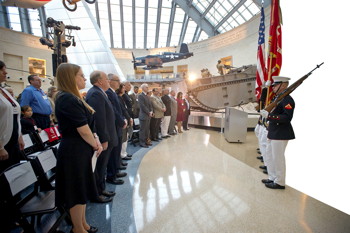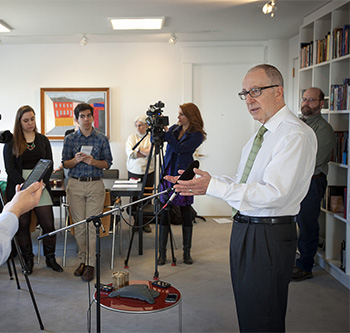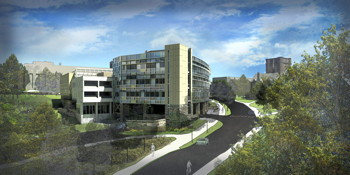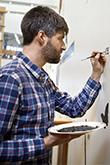ESSENTIALS
The Essentials
CORNELL PEOPLEPaying tribute to Rick Gannon '95

Ceremony for Rick Gannon at National Museum of the Marine Corps. Photo: Johnny Bivera. See larger image
Maj. Richard "Rick" J. Gannon II '95 was one of two Cornellians who were killed in action in Iraq or Afghanistan. On March 30, Cornell paid tribute to Gannon at The National Museum of the Marine Corps, where his name has been inscribed in the Commandant's Circle of the Leatherneck Gallery. The inscription was paid for by an alumnus who wishes to remain anonymous.
More than 115 alumni, parents and friends attended the program and reception.
Speakers included Lt. Gen. Robert "Rusty" Blackman '70, a retired Marine Corps three-star general who is president and CEO of the Marine Corps Heritage Foundation; Gen. John M. "Jay" Paxton Jr. '73, a four-star general and the second-highest ranking officer in the United States Marine Corps; Cornell President David Skorton; Gannon's friend Brian Drumm '96; and A'ndrea Van Schoick, president of the Cornell Club of Washington. Gannon's widow, Sally, gave brief remarks to thank the organizers.
Search for Cornell's 13th president underway

President David Skorton speaks to the media. Photo: University Communications Marketing. See larger image
Following Cornell President David Skorton's March announcement that he will step down in July 2015 to become secretary of the Smithsonian Institution, board of trustees Chairman Robert Harrison '76 appointed a 19-member Presidential Search Committee, headed by Jan Rock Zubrow '77, chair of the Executive Committee.
"This is going to be a great search," said Zubrow. "Cornell is in a wonderful position in terms of its reputation, academic stature and financial position, and that bodes very well for this process. David Skorton has done an outstanding job."
Chairs Emeriti Peter Meinig '61 and Harold Tanner '52 are advising the search committee.
New health center design takes shapeCornell has unveiled the design for a new university health center planned to open in 2017.
The proposed center, designed by Chiang O'Brien Architects and Trowbridge Wolf Michaels Landscape Architects, is a new structure integrated into the current facility and will increase usable space for campus health services from 25,000 to 52,000 square feet.

Design rendering of new health center. Image: Provided See larger image
The $55 million project is being funded in part through a partnership of Cornell's schools and colleges and the central administration, including a lead investment from Student and Academic Services.
About one-third of the total cost is being raised through philanthropy. New gifts and commitments totaling $9.81 million have been received toward a $25 million goal.
The lead gift of $5 million was made last July by Cornell Board of Trustees Chairman Robert Harrison '76 and his wife, Jane. Since then, other donors have stepped forward, including emeritus board member Martin Tang '70, who made his gift in memory of his mother and grandmother.
Gannett opened in 1956, and the last significant expansion to the building was in 1979, when Cornell had 5,000 fewer students. Pending approvals, construction is slated to begin in the spring of 2015.
Silhouette mural takes flight on bird lab wall

Artist James Prosek paints bird silhouette mural at Lab of Ornithology. Photo: University Communications Marketing. See larger image
A permanent exhibit of simple black silhouettes of North and South American birds now graces the white north wall of the visitor's center in the Imogene Powers Johnson Center for Birds and Biodiversity, home of the Cornell Lab of Ornithology.

Bird silhouette mural at Lab of Ornithology. Photo: University Communications Marketing See larger image
The 120-by-40-foot mural, by Connecticut artist James Prosek, also features black retro-styled numbers next to each silhouette, suggesting a legend with species names. But Prosek purposefully left the key off the wall, as a way to force viewers to inquire or reflect on different aspects of each image and to realize that knowing the name of an animal does not alone actually confer much information.
His mural is also a tribute to Roger Tory Peterson's 1934 "Guide to Birds" and its endpapers, which have silhouettes of birds with numbers that match a list of names.
Prosek's silhouettes are part of the lab's 2015 centennial celebration, which will acknowledge the lab's long history of combining science with the visual arts. The lab has commissioned permanent installations by Maya Lin, Jane Kim and Prosek. The other two installations are pending.
The wall features 140 different bird species and 170 total birds.
Semester abroad in Havana

Students in Havana. Photo: Olga Tserej. See larger image
For the first time, Cornell students will have the opportunity to spend a semester abroad in Cuba, conducting research and taking courses at the University of Havana.
Beginning this August, students concentrating in the life sciences and enrolled full time in Havana for fall or spring semester will split their time between regular classes and biological laboratory and field research.
Fredrik Logevall, Cornell vice provost for international affairs, and Gustavo Cobreiro, rector of the University of Havana, recently signed an agreement on the Cornell Cuba Research Program – the first at any U.S. school to join American and Cuban science students in research.
The program will begin with two biology labs in Havana, taking up to two students initially.